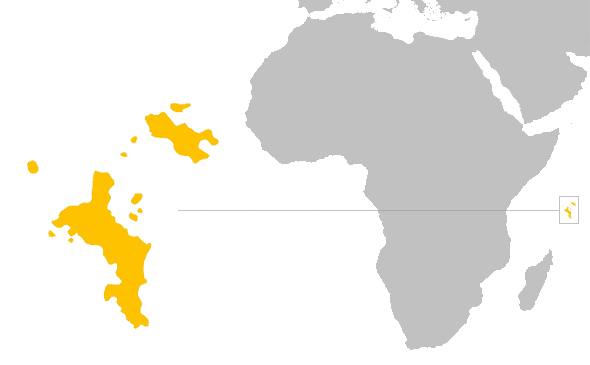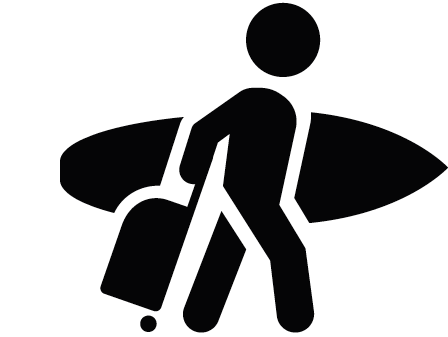Surfing in Seychelles

The Seychelles Islands (pronounced:SAY+SHELLZS) are formed by 115 islands in the Indian Ocean on the East side of Africa and it’s famous for the stunning beaches, the turquoise waters and the exotic nature enriched by a constant equatorial climate. The two main Islands are La Digue and Mahé, the latter is home to the smallest capital of Africa, Victoria. It also has the mountain rainforests of Morne Seychellois National Park and gorgeous beaches, including Beau Vallon and Anse Takamaka. Surfing in the Seychelles became famous after the island featured in Surfing Magazine in 1967 and was described as a surfer’s paradise by the australian photographer Ron Perrot. Since then many adventurous surfers started to visit the island in search of mellow, uncrowded and clean waves with jaw dropping set ups.
Climate in Seychelles
Lying in the western Indian Ocean the Seychelles have a tropical marine climate regulated by the monsoons. The temperature is warm all over all year ranging from 24-32°C. From May to October the SE wind brings a dry and cool period. November is a transition month and it’s when the winds start to change bringing light and warmer winds. It’s also the beginning of the rainy season. From December to March the predominant winds are the northwest that bring lots of humidity. The wettest months are usually December and January with heavy rains most of the afternoons. This is when the vegetation gets very lush, the winds are light and the temperatures are high. April is another transition month. The winds start to die and swing back to SE. The best months to surf in the Seychelles are from April to September, but there are always waves to be found throughout the whole year.
Best surf spots in Seychelles
The best waves in the Seychelles Islands are found at Mahé and La Digue. Nearly all the surf spots in La Digue are found on the SE coast. The most popular surf break is at the beach of Grand Anse. There are also many outer reef surf spots to be explored but those require a boat in order to be reached. In the main island of Mahé it’s where you will find most of the registered breaks in the archipelago. There are surf spots for all kinds of surfers from beginners beach breaks to experts reef point breaks. Here are some of the best breaks in Mahé: Grand Anse Beach, Intendance Beach, Anse Gaulette, Rocha Copra & Plantation Club Beach, Anse Forbans, Quarry, Anse Poules Bleu, Soleil D’Or, Carana Beach and Bel Ombre.
La Digue Island: Grand Anse Beach, Petit Anse Beach, Anse Coco and Anse Patate.
Budget Planning
Meal price range
Simple or set meals cost around $6 USD. Midrange meals in restaurants range from $15-20 USD with beers. Dining & drinking at high-end restaurants can cost anywhere from $50-80 USD.
Equipment rental
Board rentals can be a little pricey and cost anywhere from $25-36 USD for the day.
Prepaid SIM cards
Airtel and Cable & Wireless are the most popular SIM card providers. Plans range from $4-36 USD for 50-2,500MB. Cards are available for purchase at local supermarkets.
Public transport
The most popular way to travel between the islands is by ferry. Cat Cocos provides regular service between the main islands. Ticket prices range from $18-86 USD/one way. Once on an island getting around is easy via car, taxi or local bus. On Praslin and La Digue bicycles are widely used and easy to rent at $10 USD. Renting a car will set you back $40-50 USD a day.
Gas prices
$1.40 USD a liter.
Types of risks
Some of the popular spots have coral reef breaks. The waves can be inconsistent. Seychelles lies outside the cyclone belt, so severe storms are rare; short droughts possible
How to prepare
Visa
All foreign nationals are granted visa free access. You must have a valid passport, return or onward ticket, proof of accommodation and sufficient funds. The Visitor’s Permit is issued free of charge and is valid for up to three months.
Vaccines
Although it's not mandatory, it’s recommended that you have been vaccinated for hepatitis A & B, yellow fever, typhoid, rabies, meningitis, polio, Tdap, chickenpox, shingles, pneumonia, influenza, measles, mumps and rubella. You’ll be asked to show proof of your yellow fever vaccination if you come from a country with a risk of yellow fever.
Things to know
Language & Currency
The national languages are Creole, English and French. The Seychellois speak English fluently. The currency used is Seychelles rupee (Rs).
Best time to go
The best time for small clean waves is between November and March. From April to October you’ll get some bigger surf more suited for intermediate to advanced surfers.
Checking Surf forecast
Checking the forecast about a week before your trip is always a good idea. Understanding what the waves will be like and knowing what gear to pack is essential. You can check the forecast for the waves here.
Travel/Surf Insurance
World Nomads has great travel insurance packages that are not super expensive and they cover surfing.
Do I need pack a pharmacy kit
You should bring a basic kit. Including ear drops, eye drops, bandaids, imodium- for rehydrating, ear plugs, gaze, alcohol, mosquito repellent and broad spectrum antibiotic ointment.
Emergency
Dial 999 for the police, fire and rescue service.
Check out pictures of the surf in Seychelles at #surfseychelles.

